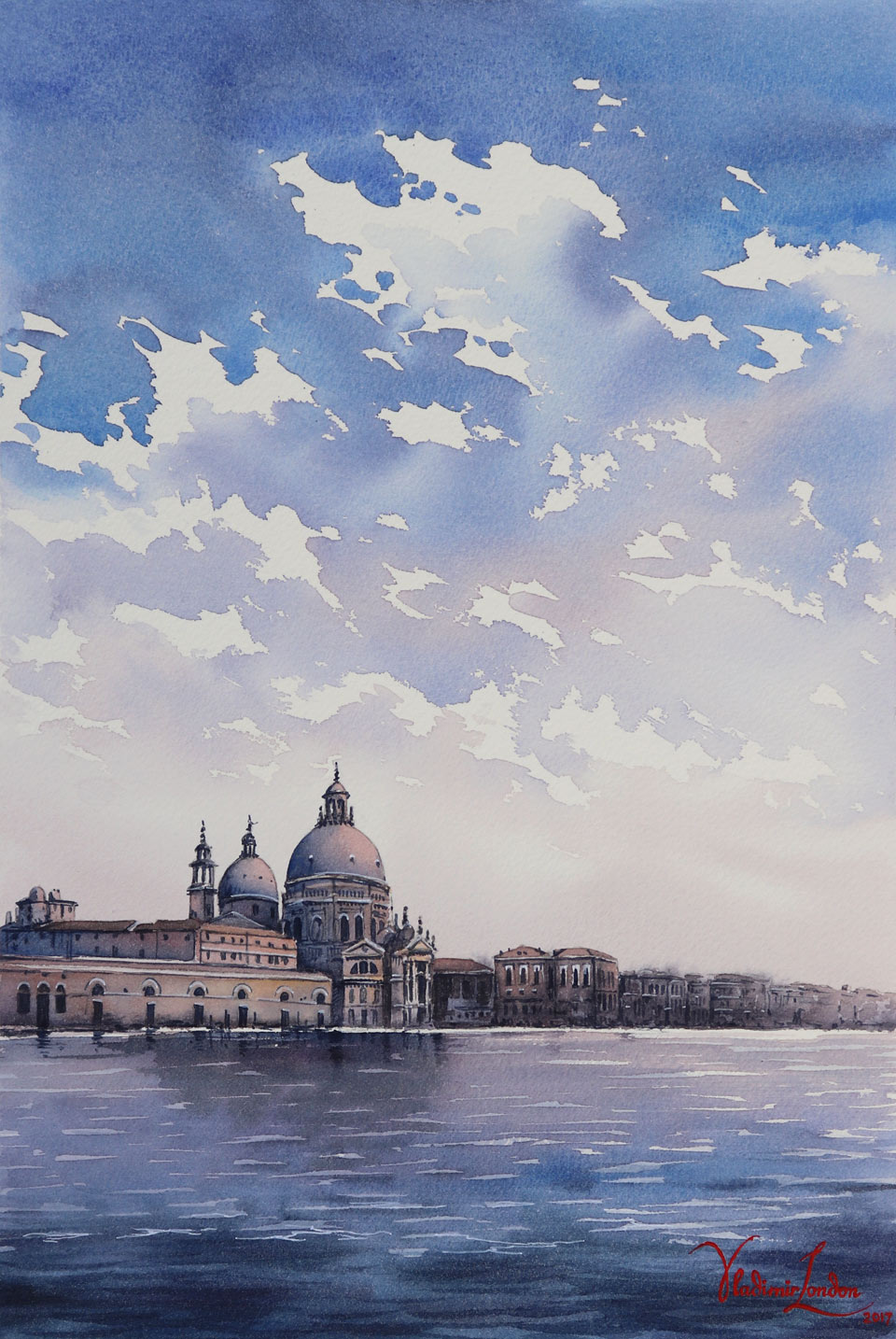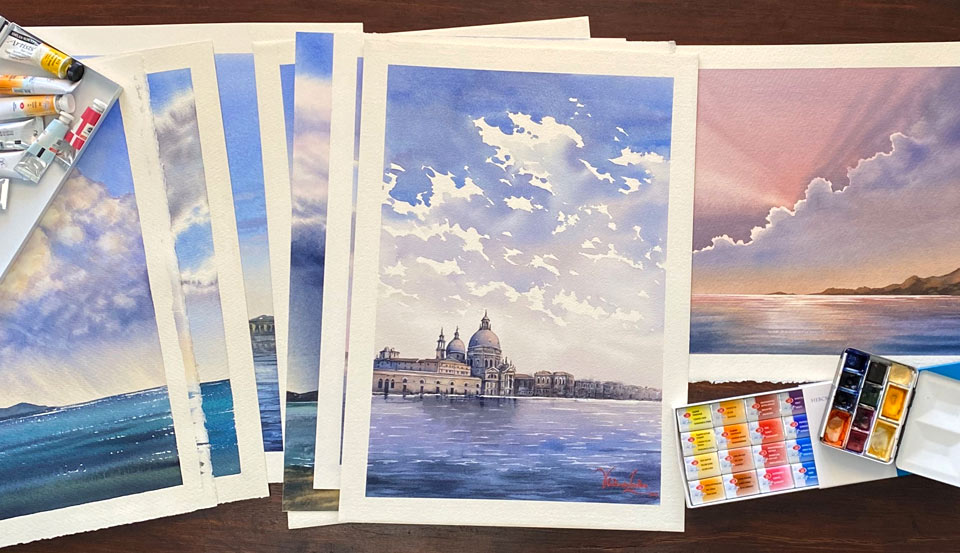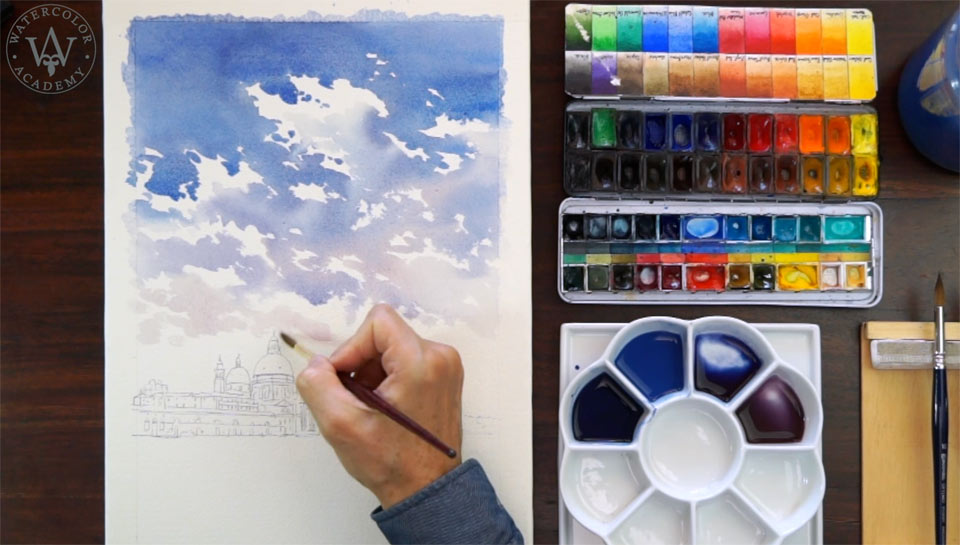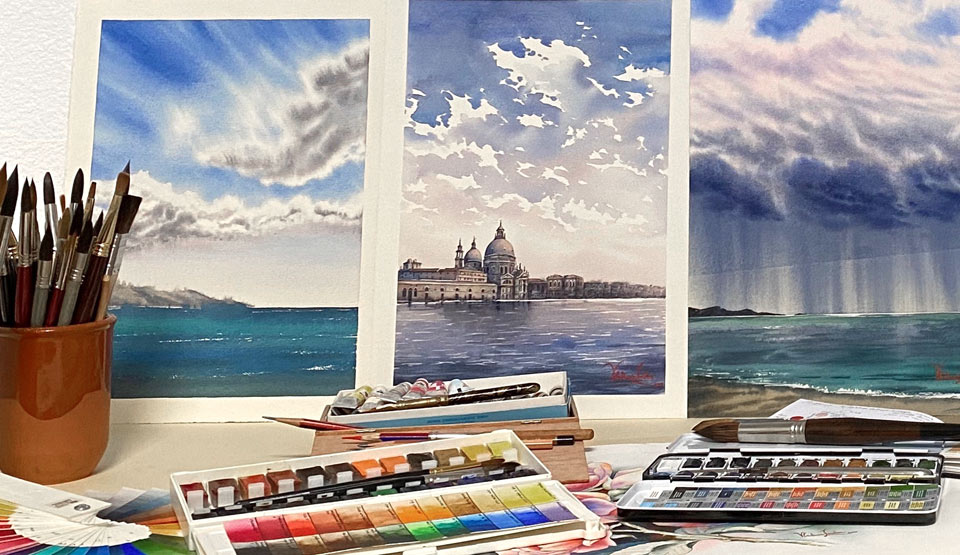A self-study, self-paced course where you can learn how to paint in watercolor by watching video lessons and doing assignments
$297 USD
ENROLL NOWA self-study, self-paced course where you can learn how to paint in watercolor by watching video lessons and doing assignments
$297 USD
ENROLL NOWOne-to-one, unlimited and custom-tailored to your skills and needs Personal Tutoring by the Watercolor Academy teachers
$997 USD
ENROLL NOWVideo lesson by Vladimir London
In this video lesson, you will discover how to paint sky and water using the wet-on-dry variegated wash.
This is the finished artwork, which I will achieve by the end of this video lesson.

I will make a wash with a soft mop brush from Escoda. To begin with, I premix several blue pigments in the quantities sufficient for the entire wash. Please keep in mind that this is not a 'repeat after me' parrot-style workshop, as this would have a very shallow educational value. What I want you to learn in the video lesson, is not how to make this particular picture, but how to use the variegated wash watercolor painting method for painting any landscape artwork you like. This is why the names of pigments that will be used for this wash are absolutely irrelevant, because you may or may not have some of them in your paint box, and the sky in your artwork may consist of different blue colors than in this painting. I don't want you to reach an erroneous conclusion that a good landscape depends on any particular paints. Above all, making a good landscape artwork fully depends on your painting skills. This is what I will be teaching you in this lesson, not how to buy a particular paint which you may not have.
To paint a realistic sky, you have to keep in mind the following: a sky is not uniform in color and tone, a cloudless clear sky is darker in zenith, and it is lighter and warmer the closer it gets to the horizon. That is why I start with a dark and cold blue color mix at the top of this artwork. Which paint to choose, in order to achieve a dark and cold blue color, is totally up to you. Whether it is blue Ultramarine or Cobalt blue, pure or mixed with some other pigment, doesn't make any difference for the purpose of this lesson.

The sky will look different depending on the weather, light, clouds, location, and so on. Its color will change throughout the day, from sunrise to sunset. There is no magic blue paint that will work in every single case. In order to become good at painting sky, you have to learn not which paints to use, but how to apply them. Don't get me wrong here – having a deep knowledge of color theory is very important for you. A good understanding of how to get different blue colors, their darker shades and lighter tints, colder and warmer temperatures, and high and low saturations, is all essential knowledge. But this is not the video lesson for color theory, so if you are left with some doubts of which paints to use, I would advise that you go back to the color theory lessons and refresh your knowledge. Let's move on to the topic of this video lesson. I already mentioned that, at the top, the sky is dark and cold, and to make it a bit more interesting, you may use not one, but two or three pigments. Usually, going more than three pigments is not required, and may affect the brilliance of the color you use.
I am painting this sky in alla prima, which means 'from the first attempt', painting it from the top down, using the variegated wash and applying it wet-from-dry. This method, for the sky, works as follows: I begin from the top, and apply the cold mix in full strength. Keep in mind that the paint will get lighter when dry; therefore, you may go 15-20% darker than you would like in the finished artwork. While the paint is wet, I continue with another mix of paint, applying it next to the already painted areas, slightly overlapping the borders. This allows the paint to flow from one area to another, intermixing directly on paper. This is what makes this wash variegated from one color to another. The white color of clouds is reserved by painting around them.

The excess paint bead that collects on top of the white clouds can be absorbed with a damp brush. The white clouds have hard borders because I am painting them wet-on-dry. The lower I go, the lighter the tone I apply; therefore, this is not only a variegated wash, but also a gradated wash from darker to lighter tones, as I am advancing from top to bottom. At the same time, I am changing the temperature of the wash, going from cold to warmer colors. Because there are so many things to keep in mind simultaneously – the tone, hue, saturation, color temperature, and the mechanical task of painting around white clouds – it is better to premix the necessary range of blue colors. This means that mixing pigments on the palette will not occupy your brain, allowing you to take your time while you are concentrating on painting.
You can see that this sky is actually a variegated wash, that goes from one color to another and changes its tone simultaneously. However, this is different from the variegated washes that I already have demonstrated in previous video lessons, in that it is interrupted with white unpainted spots of paper that create an illusion of clouds. I will not concentrate too much on the view of Venice, because the topic of the lesson is not how to paint a cityscape, but sky and water. How to paint a cityscape, including views of Venice, will be explained and demonstrated in separate video lessons.

Now, let's see how the variegated wet-on-dry wash can be used to depict water. There is one rule that you need to keep in mind when painting water, including a sea, a river, or a lake. Big stretches of water reflect the sky, hence why the light to dark contrast will be reversed. In most cases, the water tonal values will be lighter closer to the horizon, and darker on the foreground. Also, a reflection is always darker than the original light. That is why I am painting this water using almost the same pigments, but with lighter and warmer colors at the top and continuing down with darker and colder colors. This variegated wash is also interrupted by white unpainted spots, which are left to signify white waves on the water surface. When painting waves, keep in mind the rule of perspective: that the further they are, the smaller they appear.
I have done the variegated wash wet-on-dry, and now I will continue painting wet-into-wet. It is essential not to overload the paint brush with water, otherwise these wide, dark brushstrokes will spread out uncontrollably, and paint will run down across the paper surface. The board is still tilted at about 15 degrees, so should I produce a bead, it will run down in streams. That is why I load the brush with more pigment and less water than for the washes. While the paint is still wet, I can add a dark reflection under the building, and this reflection will diffuse nicely, before the paint fully dries.
I have completed the variegated wash for the sky and water, and all that is remaining, is to paint the architecture on the background. While I am at it, I will recap the main steps of how to paint sky and water using the variegated wash wet-on-dry. First of all, you have to decide on which colors you would like to use for the entire wash; you can test color combinations on a separate sheet of watercolor paper. Then, you have to premix the chosen colors to be sufficient for the entire wash.
At the top, the color of the sky is colder and darker in tone, and you should apply it with full strength, keeping in mind that it will become slightly lighter when the paint is dry. To make a wash, you have to make sure that there is enough bead on the paper surface. The paint will only flow when there is enough water. The board should be tilted at about 15 degrees, to allow the paint to flow down and collect into the bead. If the bead dries out, this would cease being a wash, because the paint will not flow from one color to another and intermix on paper. Different colors have to be applied next to each other, and their borders need to be overlapped for the paint to flow freely from one area to another.
The variegated wash means that different colors are placed next to each other, and mixed under the gravity on paper. Different colors doesn't necessary mean very different hues. For example, you can make 3, 4 or 5 different mixes that will have slightly different colors and pigment concentration. For example, one mix will be the main color of the sky; another mix should be a bit colder and darker, and one more mix should be lighter and warmer. You can also mix some intermediate steps of colors and tones to make the coloristic gamut of the sky wider. The same or slightly different pigments can be mixed for the water, but only in slightly darker tones. The variegated wash will go from the top down, starting from the dark and cold colors of the sky, then changing to the main color, and gradually progressing to lighter and warmer tints closer to the horizon. The sequence of tones and colors for the water will be reversed, from light and warm to dark and cold colors...
A self-study, self-paced course where you can learn how to paint in watercolor by watching video lessons and doing assignments
One-time payment - Lifetime membership
$297 USD
One-to-one, unlimited and custom-tailored to your skills and needs Personal Tutoring by the Watercolor Academy teachers
One-time payment - Lifetime membership
$997 USD